FEPCOS-J (1) – Description, Impressions of Usage, Current State
- April 26, 2023
- 3638 Unique Views
- 9 min read
- A developer uses the FEPCOS-J Annotation Module for the programming of a system specification. Afterwards, the FEPCOS-J Processor can generate a system import module and a system export module out of the code.
- The FEPCOS-J Exporter provides access to the compiled system specification via an IPv4-network. Thereupon, a system user can access it by means of a generated system interface, the system import module contains.
- Programming of the basic system – adder
- fjp processes the system specification; fjx provides access to it via an IPv4-network.
- Using jshell to access the specified system via the network.
Abstract: FEPCOS-J has arisen in the context of my work in the field of robot sensor networks. It implements a Java-language extension that frees a Java developer from network programming and supports cross-system concurrency. This article gives you an impression of using FEPCOS-J based on a simple example.
So far, FEPCOS-J is a prototype with 1629 lines of Java-code. I develop and test it on my own within a toy robot-based amd64 / x64 Linux OpenJDK 17 environment, which communicates via a private and secured IPv4-network.
You can contribute so that FEPCOS-J becomes Free/Libre and Open-Source Software (FLOSS).
Introduction
When I was a child, I loved to create things out of building blocks — this has never changed (Fig. 1). It is a pleasure for me to compose parts into a new whole. This also applies for programming.
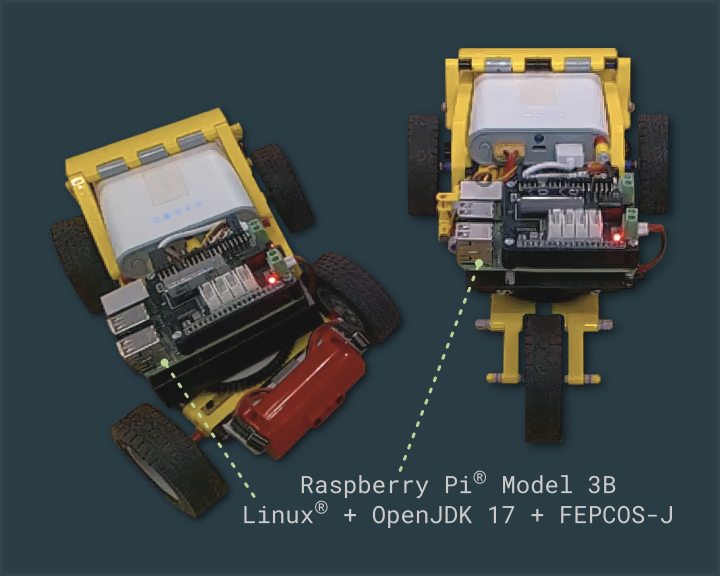
I am a computer scientist who has researched and worked in the field of robot sensor networks since 2004. A network I have worked on was based on Java-programmable SunSPOTs (spots). [1,2,3].
There were up to a hundred spots (the number depended on the experiment) that had to interact and fulfill a common task. The network was a new whole composed of parts — the spots. In this situation, I considered both the whole and each individual part as a system that I had to program.
This abstraction has helped me handle the complexity. In the following years, I have dug deeper into this matter. Among others, FEPCOS-J has arisen in this context. [4,5,6].
Outline
This post is organized as follows:
Firstly, the section FEPCOS-J – Description briefs you on the idea and concept of FEPCOS-J. In this context, I introduce its essential parts, especially two tools: fjp and fjx. Further, I explain the expressions and abbreviations I am using in this post.
Secondly, the section FEPCOS-J – Impressions of Usage gives you an impression of the use of FEPCOS-J based on the following example: A system shall provide the capability to add two numbers via an IPv4-network. In this context, I explain the complete code that is required to specify this system. Further, I describe how to make it accessible via the network. Finally, I present how to access the system via the network by means of jshell.
Thirdly, the section FEPCOS-J – Current State describes the actual test and development environment (Fig. 1 shows a part of it). In addition, the section lists restrictions and supported features of FEPCOS-J. Further, I provide numbers that give you an impression of the complexity of the software.
Lastly, the section Conclusion and Outlook concludes this post and announces my next post. Further, I encourage you to contribute so that FEPCOS-J becomes Free/Libre and Open-Source Software.
FEPCOS-J – Description
FEPCOS-J implements a model-based Java-language extension for declarative programming of networked systems. It frees a developer from network programming and supports cross-system concurrency.
For this purpose, FEPCOS-J provides:
- the FEPCOS-J Annotation Module FAM;
- the FEPCOS-J Processor fjp;
- the FEPCOS-J Exporter fjx;
- additional modules realized as modular jar-files.
To clarify, networked systems are either basic systems or composed systems; both types communicate via an IPv4-network. Basic systems are the fundamental building blocks. Composed systems use other networked systems as parts. The capabilities of a system are the activities it can execute.
Further, cross-system concurrency means that the systems can operate independently from each other. So, a system user can trigger the execution of an activity on a remote system both blockingly and concurrently. In the first case, the system user waits until it gets the result of the execution from the remote system. In the second case, the system user can do something while the remote system executes the triggered activity.
A developer uses the FEPCOS-J Annotation Module for the programming of a system specification. Afterwards, the FEPCOS-J Processor can generate a system import module and a system export module out of the code.
A developer programs a system specification as a Java-module (Fig. 2). In detail, it specifies a system and its capabilities by means of the Java-annotations FAM provides.
After that, the developer uses fjp to process the system specification. Thereupon, fjp generates two modular jar-files – the system export module (SXM) and the system import module (SIM).
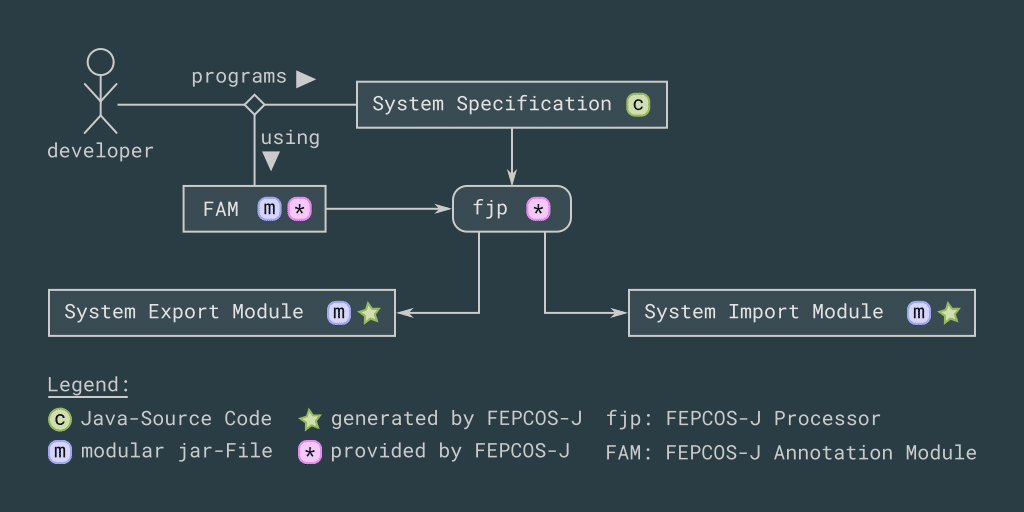
The FEPCOS-J Exporter provides access to the compiled system specification via an IPv4-network. Thereupon, a system user can access it by means of a generated system interface, the system import module contains.
SXM and SIM are deployed to two different Java Runtime Environments that can communicate via an IPv4-network (Fig. 3).
One environment contains SXM and runs fjx, which provides access to the compiled system specification via an internet socket.
The other environment contains SIM and runs the system application. In addition, it contains a system user that accesses the system specification via the network.
This access can be both blocking and concurrent. fjp generates a corresponding system interface and an adapter. They handle the required coordination and network communication together with additional modules FEPCOS-J provides.
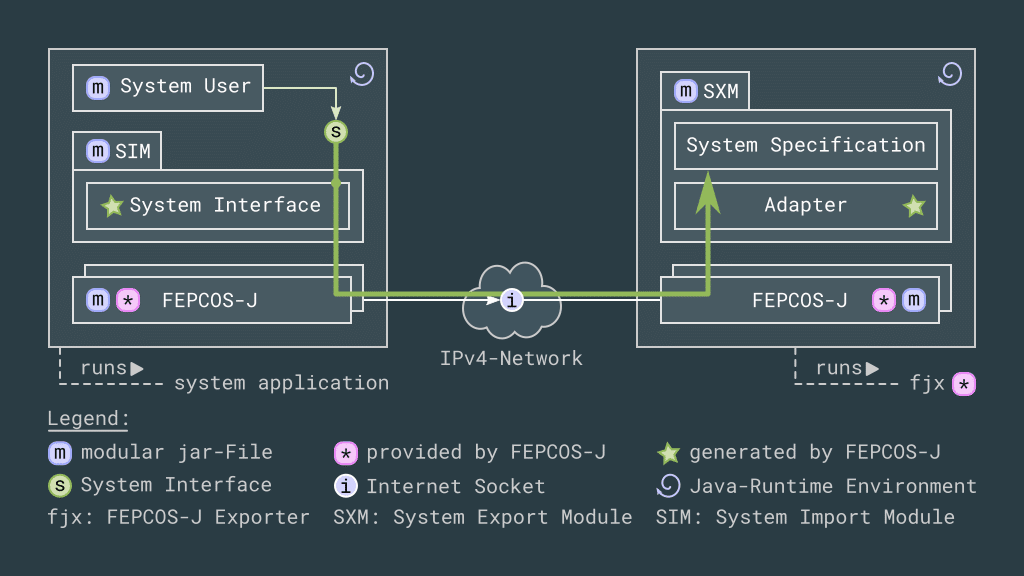
FEPCOS-J – Impressions of Usage
This section describes a typical workflow for Java-programming with FEPCOS-J. In particular, it explains the complete Java-source code of a system specification by using the following example:
A basic system adder shall provide the capability to add two numbers via an IPv4-network. A system user shall get both blocking and concurrent access to it via the internet socket 10.0.0.1:11111.
Programming of the basic system – adder
The developer realizes the system specification as a Java-module adder.spec. For this purpose, it programs the module information module-info.java, the system declaration Sy.java, and the activity specification Add.java (Fig. 4a).
The following describes the Java-code in detail.
Module information module-info.java
The module adder.spec realizes the system specification and requires the annotations FEPCOS-J provides in the module fepcos.annotations for compile time. The two packages, fepcos.sy and fepcos.ay, belong to fepcos.annotations. These two packages contain all the annotations used for this example.
module adder.spec {
requires static fepcos.annotations;
}
System declaration Sy.java
The class SY belongs to the package adder.spec and imports fepcos.sy, which contains the annotations @SYDec and @Cap. The following explains their usage.
@SYDec specifies that the annotated class SY is the system declaration. fjp uses the String of the annotation to generate the documentation. @Cap declares a capability add, which the class Add realizes.
package adder.spec;
import fepcos.sy.*;
@SYDec("A system that adds numbers.")
class SY {
@Cap Add add;
}
Activity specification Add.java
The class Add also belongs to the package adder.spec. Further, it imports fepcos.ay, which contains the annotations @AYSpec, @In, @Out, and @Behavior. The following explains their usage.
@AYSpec specifies that the annotated class Add is the activity specification. @In declares the input parameters x and y, and @Out the output parameter z. @Behavior annotates the method go(), which realizes the behavior: x and y are added, and the result is stored in z.
fjp uses all Strings in the annotations to generate the documentation.
package adder.spec;
import fepcos.ay.*;
@AYSpec("Add two numbers x,y and returns the result z.")
class Add {
@In("First summand.") int x;
@In("Second summand.") int y;
@Out("The sum.") int z;
@Behavior
void go() {
z = x + y;
}
}
fjp processes the system specification; fjx provides access to it via an IPv4-network.
Thereafter, the developer uses fjp (Fig. 4b), which processes the system specification and stores the output in the folder tgt (Fig. 4c). As a result, fjp generates the system export module adder.exp.jar, the system import module adder.imp.jar, and the documentation of the system interface adder.imp-doc.zip.
At last, the developer uses fjx to make the system specification accessible via the IP-network (Fig. 4d). For this purpose, it specifies the following parameters: tgt is the folder that contains adder.exp.jar; adder.exp is the name of the system export module; and 11111 is the port on which fjx is listening for incoming requests.
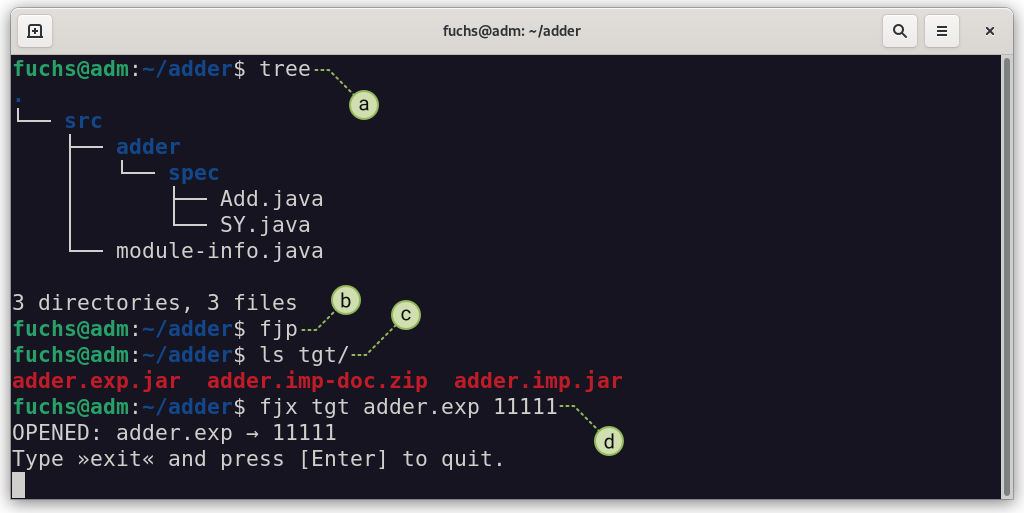
Using jshell to access the specified system via the network.
At this point, the system specification is accessible via the IP-network from another computer.
To do so, the developer must copy adder.imp.jar to this computer, as it contains the system import module adder.imp that fjp has generated. The developer sets a module path such that it contains adder.imp together with the modules FEPCOS-J provides (Fig. 5a), and starts jshell with the corresponding parameters afterwards.
The module adder.imp contains the system interface adder.S. The expression
var sy = new adder.S("10.0.0.1", 11111)
instantiates it, so that the variable sy is the reference (Fig. 4b). The passed parameters explicitly specify the internet socket at which fjx listens for incoming requests. In detail, "10.0.0.1" is the IP-address, 11111 is the port. As a result, sy provides both a blocking access sy.b and a concurrent access sy.c to the remote system.
To demonstrate this,
var r1 = sy.b.add(1,2)
causes the calling computer to wait until the remote system has added the numbers 1 and 2 and returned (Fig. 5c).
With this intention, FEPCOS-J operates in the background. In brief, it transmits the parameters via the network; sets the input parameters x=1 and y=2 of the corresponding activity specification Add; triggers go() of the class Add; transmits back the parameter z=3; and stores the result in r1.z (Fig. 5d).
Analogous to the prior expression,
var r2 = sy.c.add(3,4)
causes the concurrent execution (Fig. 5e).
But in that case, the calling computer does not have to wait for the result and could do something else. FEPCOS-J triggers a concurrent execution and returns an instance of java.util.Future. Thus, r2.get().z delivers the result 7 (Fig. 5f).
Finally, sy.close() closes the system interface (Fig. 5g).
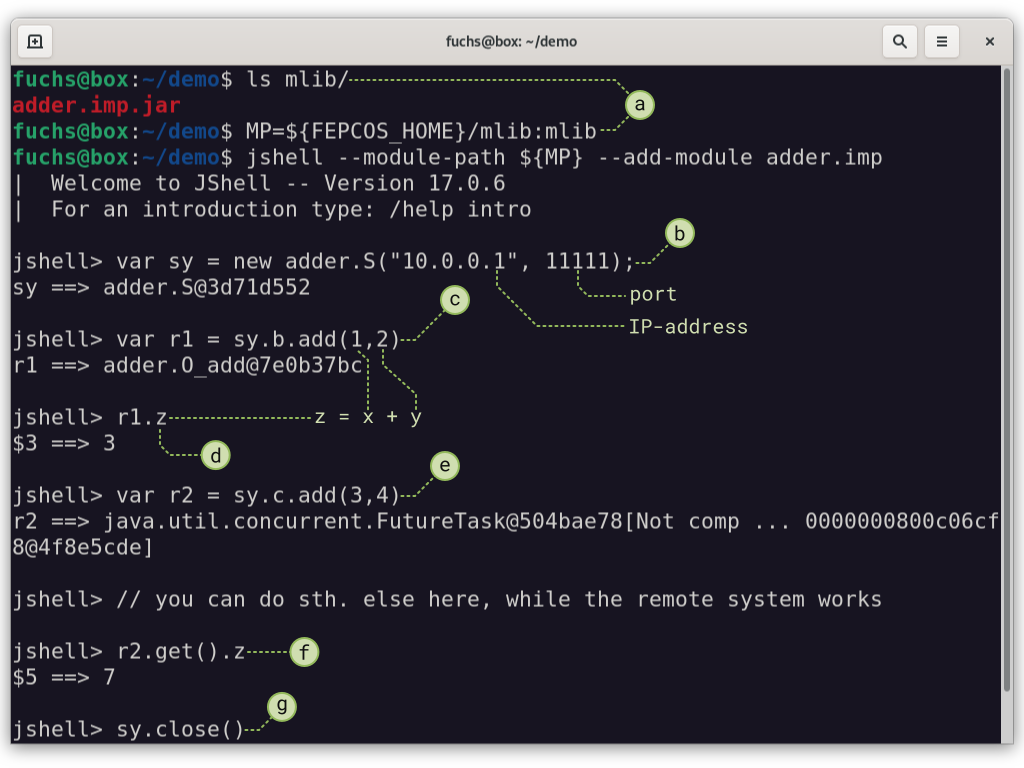
FEPCOS-J – Current State
Test and development environment
For development and testing, I am using:
- two Raspberry Pi Model 3B (arm64) controlled toy robots (Fig. 1);
- a notebook and a mini-PC (both x64);
- corresponding Linux-operating systems that host OpenJDK 17;
- a private and secured IPv4-network.
So far, I have no experience running FEPCOS-J on any other platforms.
Restrictions and supported features
Currently, FEPCOS-J is a prototype implementation that:
- does not provide any authentication or encryption. Thus, it is essential to solely use it within a private and secured network.
- solely requires Java-modules, which OpenJDK provides.
- supports the specification of basic systems, as explained in the example above. In other words, it automates network programming and supports a developer regarding cross-system concurrency by automating parts of the required Thread-programming.
- further supports the specification of composed systems, like the robot swarm shown in Fig. 1. In short, the additional annotation @Part(ip, port) allows declarative programming of "composing".
- allows the data types boolean, byte, char, double, float, int, long, short, String, and byte[] for the declaration of the activity parameters.
Numbers
The following numbers refer to the build of FEPCOS-J that I have used for the example above. Counted with cloc src, the source code of FEPCOS-J consists of:
- 53 Java-files with a total of 1629 lines of code (+ commends and blanks);
- 2 bash-files with a total of 18 lines of code (+ blanks).
Those 53 Java-files are organized in 7 modular jar-files, which require 88 kB in total, if compiled with debug level {lines,vars,source}.
So far, I am the only person who develops and uses FEPCOS-J.
Conclusion and Outlook
In this post, I have described FEPCOS-J and given you an idea of how to use it. For this purpose, I have exemplary realized a system that provides both blocking and concurrent access via an IPv4-network; this post explains the complete Java-code.
To sum up, this post demonstrates how FEPCOS-J can free you from network programming and support you regarding cross-system concurrency.
In my next post, I show how FEPCOS-J can be used to program a composed system.
I need your help so that FEPCOS-J becomes Free/Libre and Open-Source Software.
Have you thought about how FEPCOS-J can support your work?
FEPCOS-J shall become Free/Libre and Open Source Software (FLOSS).
But to achieve this, I need your help. So far, FEPCOS-J is a prototype that I have independently developed. I need your support now, especially regarding legal issues, the testing environment, and, most importantly, funding. Please provide me with feedback and share this content.
It would be great if we could establish a new, declarative way for programming networked systems in Java.
Thanks for reading!
References
- Wikipedia, The Free Encyclopedia: "Sun SPOT"; https://en.wikipedia.org/wiki/Sun_SPOT (last accessed: 2023-04-20).
- Fuchs, G. and German, R.: "UML2 activity diagram based programming of wireless sensor networks"; 2010 ICSE Workshop on Software Engineering for Sensor Network Applications (SESENA); Cape Town, South Africa; 2010; pp. 8–13; https://doi.org/10.1145/1809111.1809116.
- Fuchs, G. et al.: "Demo: The acoowee-framework"; 2011 International Conference on Distributed Computing in Sensor Systems and Workshops (DCOSS); Barcelona, Spain; 2011; pp. 1-2; https://doi.org/10.1109/DCOSS.2011.5982148.
- Fuchs, G.; "Das FEPCOS-Projekt"; http://fepcos.info (german, last accessed 2023-04-20).
- Fuchs, G.; "Vernetzte Systeme mit FEPCOS-J"; In: JAVAPRO OKT/2020; pp. 98-105; Verlag JAVAPRO; Eschborn, Germany; 10/2020 (german).
- Fuchs, G.; "Eine Java-Spracherweiterung zum Programmieren von zusammengesetzten vernetzten Systemen"; In: Java aktuell 01/2022; pp 39-46; Interessenverbund der Java User Groups e.V. (iJUG); Berlin, Germany; 12/2021 (german).
Don’t Forget to Share This Post!








Comments (0)
No comments yet. Be the first.